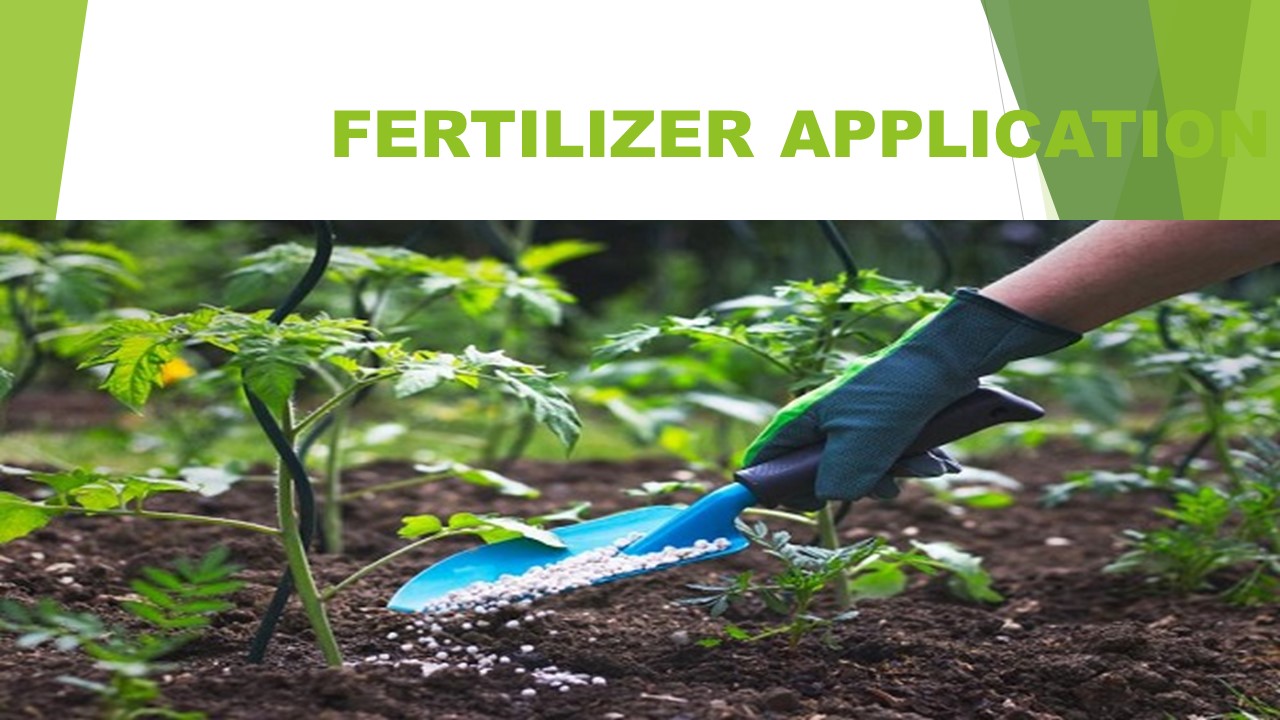FERTILIZER APPLICATION PowerPoint PPT Presentation
Title: FERTILIZER APPLICATION
1
FERTILIZER APPLICATION
2
- What is fertilizer application?
- Fertilizers are used daily by farmers and
families to help crops and gardens grow. Whether
for a small garden of flowers and plants, or a
large farm with thousands of acres of crops, a
wide range of fertilizers have been developed to
help different crops grow in different soil and
weather conditions.
3
Three Types of Pasture Species
4
- 1. Frequency of defoliation in pasture species
- Defoliation is defined as a widespread loss of
leaves or stripping of leaves on a plant. There
are many things that can cause this, such as
grazing animals like deer or rabbits, insect
infestation, disease or chemical run off from
herbicides.
5
- 2 . Intensity of defoliation in pasture species
- Defoliation intensity treatments consisted of a
range of percentage leaf area removal (0, 25, 50,
75, or 100). These treatments were applied in
parallel to a set of plants previously
undefoliated, and to a second set of plants which
had been defoliated several times at a constant
height.
6
- Impact of defoliation intensity and frequency on
N uptake and mobilization
A (15)N tracer technique was used to
quantify N uptake, mobilization, and allocation
over a 7 d period. A significant reduction in
plant N uptake was observed with the removal of
more than 75 of lamina area, but only with high
N supply. As defoliation intensity
increased, the amount of N taken up and
subsequently allocated to growing leaves during
the labelling period was maintained at the
expense of N allocation to roots and adult
leaves.
7
- Increasing defoliation intensity increased the
relative contribution of roots supplying
mobilized N to growing leaves and decreased the
relative contribution of adult leaves.
Defoliation frequency did not substantially alter
N uptake, mobilization, and allocation between
roots, adult and growing leaves on a plant basis.
However, tiller number per plant was largely
increased under repeated defoliation, hence
indicating that allocation and mobilization of N
to growing leaves, on the basis of individual
tillers, was decreased by defoliation frequency.
8
- Defoliation of broad-leaved
Defoliation of grasses
9
(No Transcript)
10
- 3. Morphological structure of pasture species
- The root morphology of ten temperate pasture
species (four annual grasses, four perennial
grasses and two annual dicots) was compared and
their responses to P and N deficiency were
characterized. Root morphologies differed
markedly some species had relatively fine and
extensive root systems (Vulpia spp., Holcus
lanatus L. and Lolium rigidum Gaudin), whilst
others had relatively thick and small root
systems (Trifolium subterraneum L. and Phalaris
aquatica L.).
11
- Most species increased the proportion of dry
matter allocated to the root system at low P and
N, compared with that at optimal nutrient supply.
Most species also decreased root diameter and
increased specific root length in response to P
deficiency. Only some of thRoot morphology was
important for the acquisition of P, a nutrient
for which supply to the plant depends on root
exploration of soil and on diffusion to the root
surface. Species with fine, extensive root
systems had low external P requirements for
maximum growth and those with thick, small root
systems generally had high external P
requirements.
12
- These intrinsic root characteristics were more
important determinants of P requirement than
changes in root morphology in response to P
deficiency. Species with different N requirements
could not be distinguished clearly by their root
morphological attributes or their response to N
deficiency, presumably because mass flow is
relatively more important for N supply to roots
in soil species responded to N deficiency in this
way.
13
- Morphology and response of roots of pasture
species to phosphorus and nitrogen nutrition - The root morphology of ten temperate pasture
species (four annual grasses, four perennial
grasses and two annual dicots) was compared and
their responses to P and N deficiency were
characterized. - Root morphologies differed markedly some
species had relatively fine and extensive root
systems (Vulpia spp., Holcus lanatus L. and
Lolium rigidum Gaudin), whilst others had
relatively thick and small root systems
(Trifolium subterraneum L. and Phalaris aquatica
L.).
14
- Root morphology was important for the
acquisition of P, a nutrient for which supply to
the plant depends on root exploration of soil and
on diffusion to the root surface. Species with
fine, extensive root systems had low external P
requirements for maximum growth and those with
thick, small root systems generally had high
external P requirements.
15
THATS ALL AND THANK YOU

